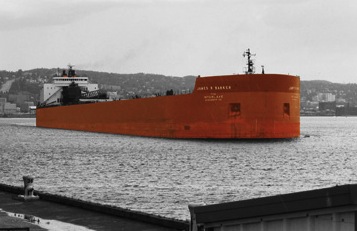The following is the text of a news release from the Interlake Steamship Co.:
(MIDDLEBURG HEIGHTS, Ohio) — M/V James R. Barker sailed into Fincantieri Bay Shipbuilding Co. in Sturgeon Bay, Wis., last week, where it will become Interlake Steamship Co.’s first 1,000-footer and its second self-unloading bulk carrier to be outfitted with exhaust gas scrubbers.
Interlake became the first U.S.-flag fleet to test scrubbers on the Great Lakes in April 2015 after pioneering the emission-reduction technology on its M/V Hon. James L. Oberstar.
Fincantieri Bay Shipbuilding handled the successful installation on the 806-foot Oberstar and was the clear front runner to earn the second phase of installations on two additional vessels: the 1,004-foot Barker and the 826-foot M/V Lee A. Tregurtha, which just arrived at the Wisconsin shipyard.
“We’re excited to extend this proven, innovative scrubber system to our 1,000-foot-class ships and further reduce our fleet’s carbon footprint,” said Interlake President Mark W. Barker. “We have the utmost confidence in the expertise and technical abilities of Fincantieri Bay Shipbuilding to implement the technology and help propel us toward our long-term vision of being an environmental leader on the Great Lakes.”
During the multi-month project at Fincantieri Bay Shipbuilding, both vessels will be equipped with the same single-inlet, closed-loop DuPont marine scrubbers from Belco Technologies Corp. (BELCO), a DuPont company, that were installed on Oberstar.
“Fincantieri Bay Shipbuilding is pleased to have been selected to lead these scrubber installation projects,” said Todd Thayse, vice president and general manager of Fincantieri Bay Shipbuilding. “Interlake’s commitment to leading environmental technology on the Great Lakes is once again demonstrated and we appreciate Interlake’s confidence in Fincantieri Bay Shipbuilding to once again partner with us for this important project.”
The scrubber units, which are attached to the exhaust system of each of the ship’s two engines, effectively strip the majority of sulfur from its stack emissions. Here’s how the systems work: Exhaust gas from the engine is sent through a series of absorption sprays that “wash” and remove impurities, specifically sulfur and particulate matter. That washed exhaust gas then travels through a droplet separator before a clean plume of white steam is discharged into the atmosphere.
“The sulfur reductions we have been able to achieve in the first year of operation have exceeded our expectations,” said Barker, adding that the additional reductions of these emissions make an even stronger case for marine transportation — the most environmentally friendly way to deliver, in Interlake’s case, raw materials.
As the first U.S.-flag fleet to implement the scrubber technology, the company was not only tasked with proving its emission-reduction capability but also taking the lead in developing a sustainable supply-and-delivery infrastructure to support its widespread use on the Great Lakes.
Specifically, the scrubber system relies on an injection of sodium hydroxide — to neutralize and remove sulfur from the exhaust gas — and that chemical has to be delivered to the vessel about twice a month.
Working with partners Hawkins Inc., PVS Chemicals Inc., Garrow Oil & Propane and OSI Environmental, the company has established waterfront supply capability at Sturgeon Bay, Wis., and Detroit, Mich. Calumet Specialties LLC has become a vital partner and stakeholder in the development of a new supply capability within the twin ports of Duluth, Minn., and Superior, Wis. A supply-and-delivery infrastructure is expected to be built out at ports located near East Chicago, Ill., and Burns Harbor, Ind.
After a successful round of sea trials, Barker and Tregurtha are expected to resume their Great Lakes trade routes by late spring.

